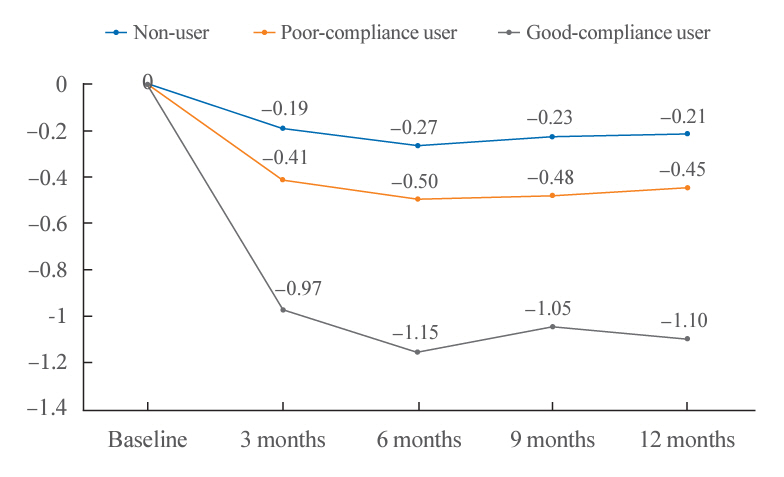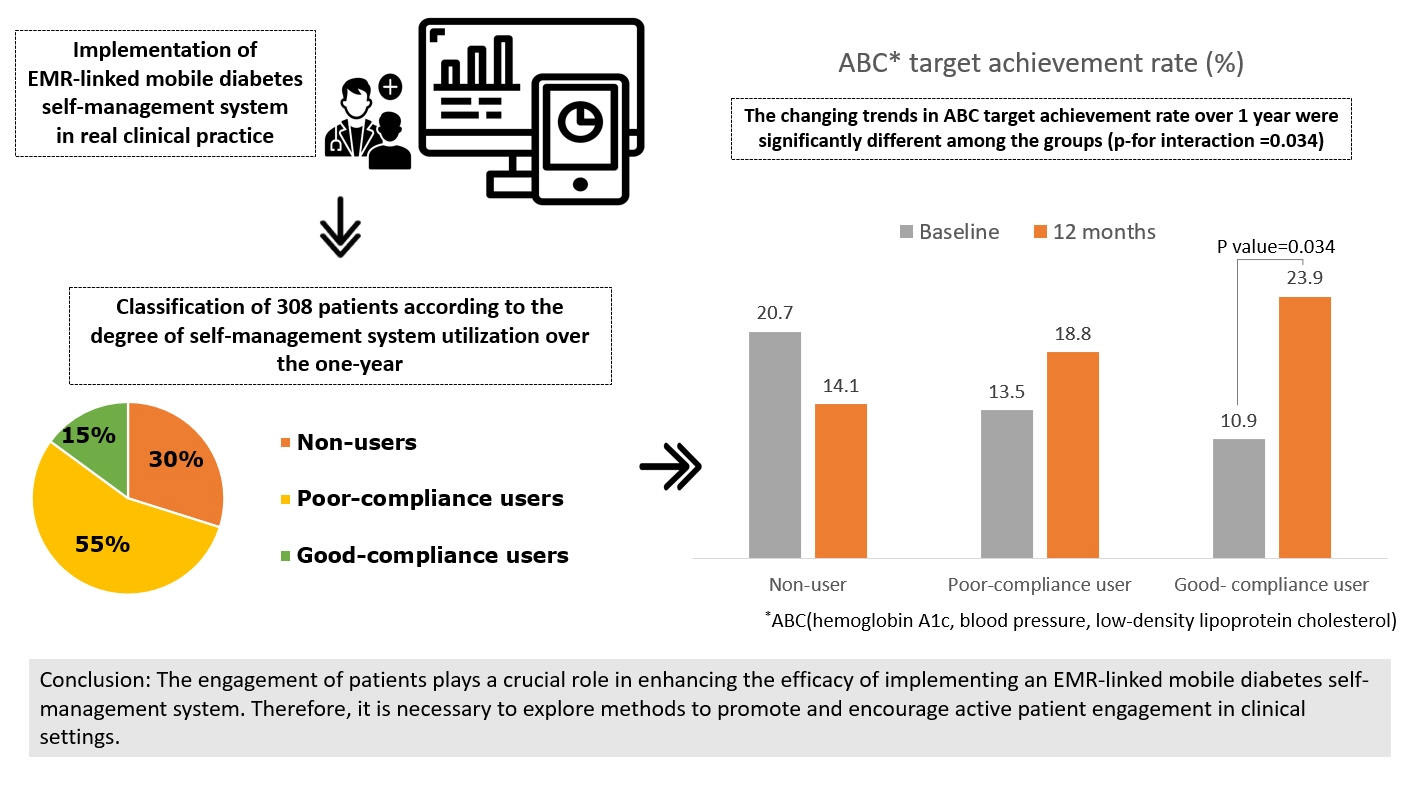Endocrinol Metab.
2024 Apr;39(2):364-374. 10.3803/EnM.2023.1878.
Effects of an Electronic Medical Records-Linked Diabetes Self-Management System on Treatment Targets in Real Clinical Practice: Retrospective, Observational Cohort Study
- Affiliations
-
- 1Department of Medical Informatics, College of Medicine, The Catholic University of Korea, Seoul, Korea
- 2Division of Endocrinology and Metabolism, Department of Internal Medicine, Seoul St. Mary’s Hospital, College of Medicine, The Catholic University of Korea, Seoul, Korea
- 3Medical Excellence Inc., Seoul, Korea
- 4The Catholic Institute of Smart Healthcare Center, The Catholic University of Korea, Seoul, Korea
- KMID: 2554641
- DOI: http://doi.org/10.3803/EnM.2023.1878
Abstract
- Background
This study evaluated the effects of a mobile diabetes management program called “iCareD” (College of Medicine, The Catholic University of Korea) which was integrated into the hospital’s electronic medical records system to minimize the workload of the healthcare team in the real clinical practice setting.
Methods
In this retrospective observational study, we recruited 308 patients. We categorized these patients based on their compliance regarding their use of the iCareD program at home; compliance was determined through self-monitored blood glucose inputs and message subscription rates. We analyzed changes in the ABC (hemoglobin A1c, blood pressure, and low-density lipoprotein cholesterol) levels from the baseline to 12 months thereafter, based on the patients’ iCareD usage patterns.
Results
The patients comprised 92 (30%) non-users, 170 (55%) poor-compliance users, and 46 (15%) good-compliance users; the ABC target achievement rate showed prominent changes in good-compliance groups from baseline to 12 months (10.9% vs. 23.9%, P<0.05), whereas no significant changes were observed for poor-compliance users and non-users (13.5% vs. 18.8%, P=0.106; 20.7% vs. 14.1%, P=0.201; respectively).
Conclusion
Implementing the iCareD can improve the ABC levels of patients with diabetes with minimal efforts of the healthcare team in real clinical settings. However, the improvement of patients’ compliance concerning the use of the system without the vigorous intervention of the healthcare team needs to be solved in the future.
Figure
Reference
-
1. International Diabetes Federation. IDF Diabetes Atlas. 10th ed. Brussels: International Diabetes Federation;2021.2. Jung CH, Son JW, Kang S, Kim WJ, Kim HS, Kim HS, et al. Diabetes fact sheets in Korea, 2020: an appraisal of current status. Diabetes Metab J. 2021; 45:1–10.
Article3. American Diabetes Association. 3. Comprehensive medical evaluation and assessment of comorbidities. Diabetes Care. 2017; 40(Suppl 1):S25–32.4. Lee KW. Costs of diabetes mellitus in Korea. Diabetes Metab J. 2011; 35:567–70.
Article5. American Diabetes Association. Standards of care in diabetes: 2023 abridged for primary care providers. Clin Diabetes. 2022; 41:4–31.6. Cahn A, Akirov A, Raz I. Digital health technology and diabetes management. J Diabetes. 2018; 10:10–7.
Article7. Perestelo-Perez L, Rivero-Santana A, Abt-Sacks A, Toledo-Chavarri A, Brito N, Alvarez-Perez Y, et al. Patient empowerment and involvement in research. Adv Exp Med Biol. 2017; 1031:249–64.8. Abrahams N, Gilson L, Levitt NS, Dave JA. Factors that influence patient empowerment in inpatient chronic care: early thoughts on a diabetes care intervention in South Africa. BMC Endocr Disord. 2019; 19:133.
Article9. American Diabetes Association. Standards of medical care in diabetes: 2022 abridged for primary care providers. Clin Diabetes. 2022; 40:10–38.10. Schmidt SK, Hemmestad L, MacDonald CS, Langberg H, Valentiner LS. Motivation and barriers to maintaining lifestyle changes in patients with type 2 diabetes after an intensive lifestyle intervention (The U-TURN Trial): a longitudinal qualitative Study. Int J Environ Res Public Health. 2020; 17:7454.
Article11. Williams DM, Parsons SN, Dunseath GJ, Stephens JW, Luzio SD, Owens DR. The impact of structured self-monitoring of blood glucose on glycaemic variability in non-insulin treated type 2 diabetes: the SMBG study, a 12-month randomized controlled trial. Diabetes Metab Syndr. 2020; 14:101–6.12. Young LA, Buse JB, Weaver MA, Vu MB, Mitchell CM, Blakeney T, et al. Glucose self-monitoring in non-insulintreated patients with type 2 diabetes in primary care settings: a randomized trial. JAMA Intern Med. 2017; 177:920–9.
Article13. Zhu H, Zhu Y, Leung SW. Is self-monitoring of blood glucose effective in improving glycaemic control in type 2 diabetes without insulin treatment: a meta-analysis of randomised controlled trials. BMJ Open. 2016; 6:e010524.
Article14. Davis WA, Bruce DG, Davis TM. Is self-monitoring of blood glucose appropriate for all type 2 diabetic patients? The Fremantle Diabetes Study. Diabetes Care. 2006; 29:1764–70.
Article15. Karter AJ, Parker MM, Moffet HH, Spence MM, Chan J, Ettner SL, et al. Longitudinal study of new and prevalent use of self-monitoring of blood glucose. Diabetes Care. 2006; 29:1757–63.
Article16. Fioravanti A, Fico G, Salvi D, Garcia-Betances RI, Arredondo MT. Automatic messaging for improving patients engagement in diabetes management: an exploratory study. Med Biol Eng Comput. 2015; 53:1285–94.
Article17. de Ridder M, Kim J, Jing Y, Khadra M, Nanan R. A systematic review on incentive-driven mobile health technology: as used in diabetes management. J Telemed Telecare. 2017; 23:26–35.
Article18. Hartz J, Yingling L, Powell-Wiley TM. Use of mobile health technology in the prevention and management of diabetes mellitus. Curr Cardiol Rep. 2016; 18:130.
Article19. Bults M, van Leersum CM, Olthuis TJ, Bekhuis RE, den Ouden ME. Barriers and drivers regarding the use of mobile health apps among patients with type 2 diabetes mellitus in the Netherlands: Explanatory Sequential Design Study. JMIR Diabetes. 2022; 7:e31451.
Article20. Lluch M. Incentives for telehealthcare deployment that support integrated care: a comparative analysis across eight European countries. Int J Integr Care. 2013; 13:e042.
Article21. Yang Y, Lee EY, Kim HS, Lee SH, Yoon KH, Cho JH. Effect of a mobile phone-based glucose-monitoring and feedback system for type 2 diabetes management in multiple primary care clinic settings: cluster randomized controlled trial. JMIR Mhealth Uhealth. 2020; 8:e16266.
Article22. Cho JH, Choi YH, Kim HS, Lee JH, Yoon KH. Effectiveness and safety of a glucose data-filtering system with automatic response software to reduce the physician workload in managing type 2 diabetes. J Telemed Telecare. 2011; 17:257–62.
Article23. Korean Diabetes Association. Treatment guideline for diabetes. 6th ed. Seoul: Medcus;2019. p. 33–100. 33-5, 88-100.24. ElSayed NA, Aleppo G, Aroda VR, Bannuru RR, Brown FM, Bruemmer D, et al. 6. Glycemic targets: standards of care in diabetes-2023. Diabetes Care. 2023; 46(Suppl 1):S97–110.25. ElSayed NA, Aleppo G, Aroda VR, Bannuru RR, Brown FM, Bruemmer D, et al. 10. Cardiovascular disease and risk management: standards of care in diabetes-2023. Diabetes Care. 2023; 46(Suppl 1):S158–90.26. Jellinger PS, Handelsman Y, Rosenblit PD, Bloomgarden ZT, Fonseca VA, Garber AJ, et al. American Association of Clinical Endocrinologists and American College of Endocrinology guidelines for management of dyslipidemia and prevention of cardiovascular disease. Endocr Pract. 2017; 23(Suppl 2):1–87.
Article27. Cho JH, Kim HS, Yoo SH, Jung CH, Lee WJ, Park CY, et al. An internet-based health gateway device for interactive communication and automatic data uploading: clinical efficacy for type 2 diabetes in a multi-centre trial. J Telemed Telecare. 2017; 23:595–604.
Article28. Lee M, Kang D, Yoon J, Shim S, Kim IR, Oh D, et al. The difference in knowledge and attitudes of using mobile health applications between actual user and non-user among adults aged 50 and older. PLoS One. 2020; 15:e0241350.
Article
- Full Text Links
- Actions
-
Cited
- CITED
-
- Close
- Share
- Similar articles
-
- Effects of an Electronic Medical Records-Linked Diabetes Self-Management System on Treatment Targets in Real Clinical Practice: Retrospective, Observational Cohort Study
- Medicine in the Fourth Industrial Revolution: What Should We Prepare?
- Treatment Patterns of Type 2 Diabetes Assessed Using a Common Data Model Based on Electronic Health Records of 2000–2019
- Implementation of a Next-Generation Electronic Nursing Records System Based on Detailed Clinical Models and Integration of Clinical Practice Guidelines
- A clinical research strategy using longitudinal observational data in the post-electronic health records era



